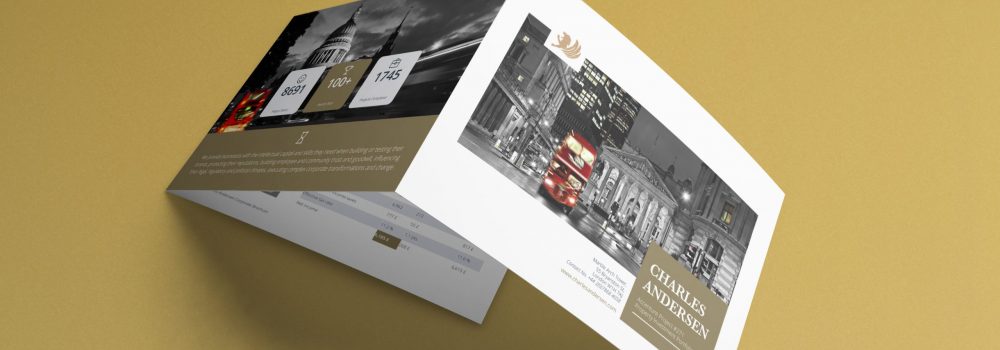The Power of Brochure Design: How to Boost Your Marketing Efforts
Introduction: Understanding the Importance of Brochure Design in Marketing
Brochures were a staple of advertising campaigns for decades, and for exact reason. They are a versatile and cost-effective way to promote your business, product or service. Brochures are able to provide a lot of information in a compact format, making them perfect for trade shows, events, or as leave-behinds for sales calls. Additionally, brochures are easy to distribute, whether in print or digital form, and can reach a wide audience.
However, not all brochures are created equal. A well-designed brochure can make a powerful impact on your target audience and help boost your marketing efforts. On the other hand, a poorly designed brochure can be easily ignored or discarded. In this article, we’ll explore the power of brochure design and how to use it to boost your marketing efforts.
The Role of Visuals in Brochure Design: How to Use Images and Graphics to Communicate Your Message
The visual elements of your brochure are often the first thing that people will notice, and they can make or break the success of your brochure. The use of high-quality images, graphics, and colors can make your brochure stand out, while poor quality visuals can detract from the overall impact of your brochure.
When selecting visual elements for your brochure, it’s important to choose images that are relevant to your message and that resonate with your target audience. Additionally, consider the use of color in your brochure. Colors can evoke certain emotions and feelings, so it’s important to choose colors that align with your brand and message.
Crafting a Compelling Copy: How to Write Effective Brochure Content
The text in your brochure is just as important as the visuals. The copy in your brochure should be clear, concise, and easy to understand. It should also be engaging, and should speak directly to your target audience.
When writing your brochure, think about the key points that you want to communicate. Then, organize your information in a logical and easy-to-follow manner. Use headings and subheadings to break up the text and make it easy to scan. Additionally, use bullet points and lists to make the information easy to read.
Designing for Your Target Audience: How to Tailor Your Brochure to Your Customers
When designing your brochure, it’s important to keep your target audience in mind. Consider their interests, needs, and pain points. Then, tailor your brochure to address those specific needs.
For example, if your target audience is a specific age group, consider the design elements that will appeal to that group. Additionally, think about the message that you want to communicate and how it will resonate with your target audience. By tailoring your brochure to your target audience, you’ll be more likely to grab their attention and get them interested in your product or service.
Measuring the Success of Your Brochure: How to Analyze the Impact of Your Brochure Design on Your Marketing Efforts
One of the key advantages of brochures is that they can be easily measured. By tracking the number of brochures distributed, the number of website visits or phone calls generated from the brochure, or the number of leads generated, you can get a good idea of the impact that your brochure is having on your marketing efforts.
The Power of Brochure Design in Marketing and How to Make the Most of It
Brochures have long been a staple of marketing campaigns due to their versatility and cost-effectiveness. They provide a lot of information in a compact format and can reach a wide audience through various distribution channels. However, it’s not just about having a brochure, it’s about having a well-designed brochure that can make a powerful impact on your target audience and help boost your marketing efforts.
The visual elements of your brochure are the first thing people will notice and can make or break the success of your brochure. High-quality images, graphics, and colors can make your brochure stand out, while poor quality visuals can detract from its overall impact. Additionally, the text in your brochure should be clear, concise and easy to understand, and should speak directly to your target audience.
When designing your brochure, it’s important to keep your target audience in mind and tailor it to address their specific needs and interests. Additionally, by tracking the success of your brochure through metrics such as the number of brochures distributed, website visits or leads generated, you can get an idea of its impact on your marketing efforts.
To make the most of your brochure design, keep your brand and message consistent across all marketing materials, incorporate interactive elements and consider testing and refining your brochure to continue to improve its effectiveness.
Conclusion
Designing a brochure that stands out and resonates with UK audiences requires an understanding of the market, creativity, and attention to detail. By following these tips and techniques, you’ll be able to create a brochure that is effective in the UK market and that helps boost your marketing efforts.
If you enjoyed this post you may want to read some of our blog posts around this subject: How Much Does It Cost to Design a Brochure?, The Anatomy of a Good Brochure Design For IT Company , Top Tips to Design an Information Technology Brochure and The Benefits of Great Technology Brochure Design
Brochure designers
If printed materials such as brochures and catalogues are not part of your marketing strategy, then you could be missing out. Creative Harmony can help you with all of your branding designs for your catalogues, brochures, product launches, and more. Plus, as your one-stop shop for all of your marketing needs, we can even print the designs or help you to distribute them digitally. Click here to find out more.


